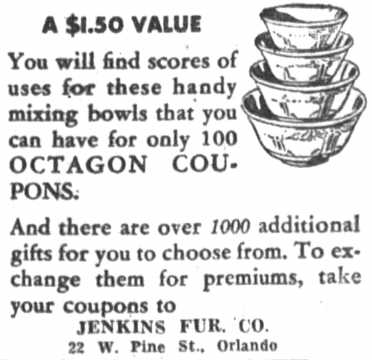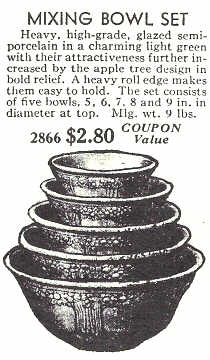|
The Appletree bowls were a set of nested mixing bowls made by Homer Laughlin during the 1930s and into the early 1940s. They were designed by art director, Frederick Rhead.
They were developed from late September to mid December 1931, The first time Rhead mentions them in his journals is on September 21, 1931:
J. M. Wells asked for Colgate Bowl, tree design 9 ¼ by 4 inches. The best height for practical use and appearance. Sample needed in 8 days [snip] to see A. V. [Albert V. Bleininger] on blue and yellow mattes [glazes] also look up green.
Later that same day he writes:
Commenced work on bowls. Model to Al Kraft and Bill [Berrisford] to model tree pattern in wax for shipping. Saw A. V. on yellow and blue mattes and gave him samples of green
For the next several days, the art department worked solely on samples of the 9 ¼" Appletree bowl. The log entries reveal the work that went into creating the piece so samples could be reviewed on time:
| Sept. 24, 1931 |
Worked all day on bowls [and] at night until 10 pm |
| Sept. 25, 1931 |
Finished modeling bowls - being blocked and cased |
| Sept. 26, 1931 |
Three of each in three colors in glost kilns - placed in kilns ourselves |
| Sept. 27, 1931 |
More bowls modeled and put in glost kilns |
| Sept. 28, 1931 |
Six bowls out satisfying. Six more out, chipped at bottoms, but glaze satisfactory |
| Sept. 30, 1931 |
J. M. Wells to NY with Colgate bowls and Woolworth's samples |
The hard work paid off. On October 2, 1931, Rhead noted that five sizes were ordered and they were to nest. The original design had to be changed so they could nest properly. On October 6th, J. M. Wells reviewed all five sizes of the Appletree bowls and Rhead had to explain, "the difference in appearance and capacity due to change in the shape for clay fit." On the 7th, modeling of the bowls was complete and an HLC embossed marking was made on the 9th.
Another design was made on November 30th. Rhead called them the "B" models and noted the sizes as 9 ¼", 8 ⅝", 7 ⅝", 6 ½", and 5 ½". Finally, on December 16, 1931, Rhead noted: "J. M. Wells phoned from NY... Colgate bowls O.K."
Colgate offered the green Appletree bowls (which tends to look more blue than green) throughout the 1930s as premiums. Customers could get sets of bowls by using their Octagon soap coupons.

|

|

|
| Copies of Colgate's Octagon soap promotions featuring the Appletree bowls, mid-1930s |
Larkin Soap premium, 1935 |
The Appletree bowls were made until the mid-1940s. The most common color is the Colgate green glaze. It is always called green in vintage advertisements and in HLC records. It can photograph as either green or blue, depending on lighting. This special green/blue glaze was also used on Empress shape teapots. The bowls were also made in melon yellow and ivory glazes. The ivory bowls were sold as either blank or decorated with colored bands or decals. The 9 ½" size can be found in OvenServe's orange (pumpkin) glaze.
There are two sizes of the largest bowl - 9 ½" and 9 ¾". Records indicate there were only five bowls to a set so the larger bowl was either sold as a separate bowl or served as a replacement for the 9 ½" version. The 9 ¾" bowl is often found either unmarked or with a general HLC backstamp and date code, usually from the 1940s.
While the official name for these bowls is Appletree, many collectors call them Orange Tree. Authors Sharon and Bob Huxford dubbed them Orange Tree when writing various editions of their Fiesta book. In the Collector's Encyclopedia of Fiesta, 8th Edition, ©1998, on page 120, they wrote, "Though we've always referred to these at the "orange tree" bowls because of their resemblance to Fenton's carnival glass pattern of the same time, some collectors call the design "peach tree."
|